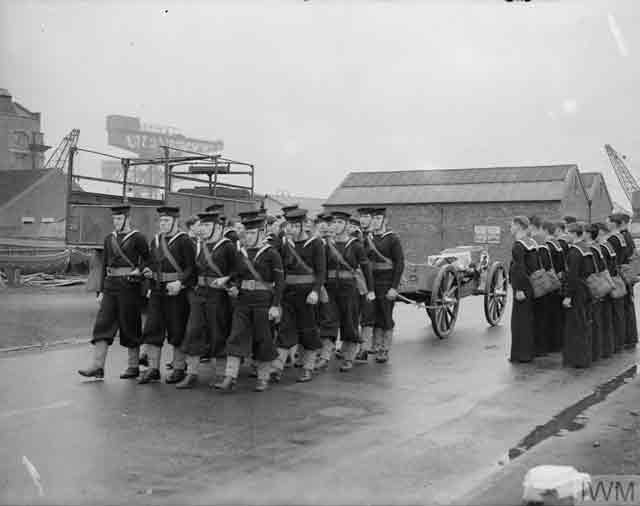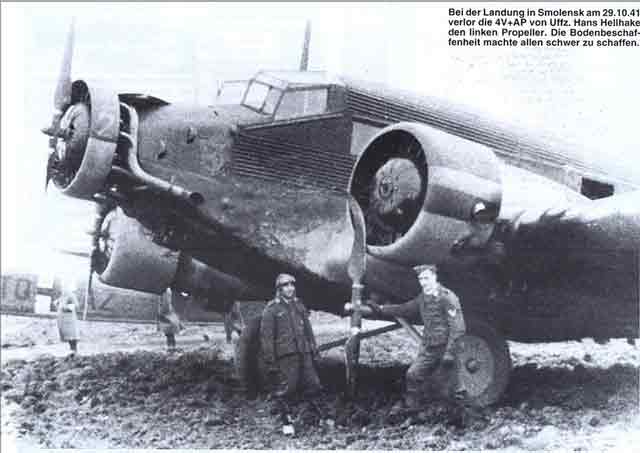Monday 27 October 1941
 |
| A Scharfschütze (sniper) team in action, October 1941. It is unclear if the propaganda photographer realized that they were using a captured Soviet Mosin-Nagant PU rifle. Both sides had outstanding snipers, and this was a virtual war-within-a-war. Some snipers preferred to work alone because that enabled them to get closer to the enemy in concealment, but a two-man team was standard. |
Eastern Front: While much of the Eastern Front is bogged down by the annual fall Rasputitsa, or muddy season, on
27 October 1941 it has not yet reached its full level in the southernmost sectors. General Erich von Manstein's 11th Army busts into the Crimea after a long struggle against fierce Red Army resistance in the Perekop Isthmus. The Soviet 51st Army retreats in the fog and mud toward the bastion of Sevastopol in the southwest, and to the Kerch Peninsula in the east. Pretty much everyone expects a fairly quick German victory and occupation.
 |
| Bellows Field (Bellows Air Force Station) in Waimanalo, Hawaii on 27 October 1941. The Imperial Japanese Navy attacks Bellows Field in addition to Pearl Harbor on 7 December 1941, though the Bellows Field attack receives little attention. |
The Crimea is one of the foundations of von Manstein's reputation - it is the reason he becomes a field marshal. However, in the grand scheme of World War II, the Crimea is a sideshow. It is useful to capture the Soviet naval base at Sevastopol, but the Soviet Black Sea fleet is never much of a hindrance to German operations. Hitler, however, is fixated on the Crimea - as he tells Finnish Marshal Mannerheim in June 1942, worries about Soviet bombers operating from the Crimea against the Romanian oil fields were one of the reasons he invaded the USSR in the first place. So, while objectively it might make more sense to simply seal off the Crimea and instead focus on the drive into the Caucasus, where success would effectively surround the Crimea anyway, its capture and retention lead to a major campaign. This ultimately is profitless and strategically pointless but occupies some of the best Wehrmacht minds and troops throughout the war.
 |
| USS Solace (AH-5) at anchor in Hawaiian waters after her arrival there on 27 October 1941. The hospital ship is present at Pearl Harbor on 7 December 1941 and saves many lives. |
Elsewhere, the Germans make some small gains. Just to the north of the Crimea, the Soviet 12th Army of Soviet Southwest Front continues withdrawing gradually and exposes more cities for the Germans to capture. German Sixth Army, for instance, takes Kramatorsk in the Donetsk Oblast north of Stalino when the city surrenders without a fight. Italian troops are involved in the Wehrmacht's occupation of the industrial Donets Basin, and the OKW issues a communique about their efforts:
In the Donets Basin, an attempt to retard our advance was prevented by Italian troops. The enemy was thrown back with heavy and bloody losses and left several hundred prisoners in the hands of our allies
The Soviet defenders in the southern sector are outmatched at this stage. However, their retreat is orderly and efficient, preventing outright breakthroughs and forcing the Germans to advance at a measured pace.
 |
| "Photo #: 80-G-6678 Douglas SBD-2 Dauntless scout bombers, of Scouting Squadron Six (VS-6) Composite photograph of 9 planes in flight, with USS Enterprise (CV-6) and a plane guard destroyer below. The original photo is dated 27 October 1941. Note differences in ocean surface wave patterns between the upper and lower images skillfully blended to combine the two photographs. Official U.S. Navy Photograph, now in the collections of the National Archives." (Navy History and Heritage Command). |
Further north, the German attack on Moscow, Operation Typhoon, is mostly shut down pending an improvement in the weather but does make some gains in some places. On the extreme southern axis of the advance, General Guderian's 2nd Panzer Army continues up the road from Mtsensk toward Moscow, with the main forces of Kampfgruppe Eberbach at Plavsk south of Tula. On the northwest axis of the advance, the 4th Panzer Army makes progress at Volokolamsk, where it has been stalled for two weeks. At Mozhaysk, the 4th Army stops dead and is allowed by Army Group Center commander Field Marshal Fedor von Bock to dig trenches - when it is supposed to be attacking. The Wehrmacht is on the outskirts of Moscow and in a good position to attack the city, but past battles have worn it down so much that it cannot make significant progress until conditions improve.
 |
| Viktor Talalikhin, Hero of the Soviet Union, was most famous for ramming a Luftwaffe Heinkel He 111 bomber with his I-16 at night in August 1941, causing both planes to crash. On 27 October 1941, Talalikhin is attacked in his Mikoyan-Gurevich MiG-3 near the village of Kamenka by a swarm of Bf-109 fighters. Talalikhin shoots down two of the fighters before being shot down in turn. Talalikhin is a permanent name on the muster list of the 1st Squadron of the 177th Fighter Aviation Regiment, with monuments to him in Moscow and Podolsk. KIA 27 October 1941 (colorized). |
The Soviets defending Tikhvin, north of Moscow, are now under the command of General Fedyuninsky, and he makes an immediate impact. He orders three Red Army divisions to attack advance elements of General Harpe's 12th Panzer Division at the village of Sitomlia about 40 km northeast of Budogsh' (Budogoshch). While Harpe's small unit is wildly outgunned, its commander decides to fight and goes into a defensive crouch while calling for reinforcements. The Red Army units attack piecemeal, like the bad guys in a karate flick who attack the hero only one at a time. Harpe is able to shift his men around just enough to hold the attackers off until help arrives. General Rudolf Schmidt, commander of 39th Army Corps and the man in charge of this portion of the advance, quickly sends the 8th Panzer and 18th Motorized Divisions to rescue the trapped men, which is accomplished by nightfall. The 12th Panzer reconnaissance team winds up doing its job - identifying the enemy units - but not quite in the way it had planned.
 |
| The original caption reads (and these may offend readers, but this is what it says): "To make room for construction in the Poznan suburb of Wallischei, a number of houses must be demolished. For this work, columns of Polish Jews are used, who get to know manual labor for the first time in their lives." (Schwahn, Ernst, Federal Archive Picture 183-2006-0320-500). |
US/German Relations: President Roosevelt, who on the 25th issued a strong statement condemning Wehrmacht atrocities on the Eastern Front, on 27 October 1941 continues his rhetorical onslaught. During a Navy Day speech (Roosevelt is a former Secretary of the Navy), Roosevelt says in part about recent U-boat attacks at sea:
I say that we do not propose to take this lying down. Our determination not to take it lying down has been expressed in the orders to the American Navy to shoot on sight. Those orders stand... [W]hen we have helped to end the curse of Hitlerism we shall help to establish a new peace which will give to decent people everywhere a better chance to live and prosper in security and in freedom and in faith. Each day that passes we are producing and providing more and more arms for the men who are fighting on actual battle-fronts. That is our primary task.
In reference to the recent U-boat torpedoing of destroyer USS Kearny, FDR adds, "Hitler’s torpedo was directed at every American….was to frighten the American people off the high seas - to force us to make a trembling retreat." This, he claims, has "aroused" the "American spirit" because "America has been attacked." However, despite this "attack," Roosevelt is not yet ready to declare war on the Reich.
 |
| Life Magazine of 27 October 1941, "Air-Raid Spotter." |
October 1941October 1, 1941: Germans and Finns Advance in USSROctober 2, 1941: Operation Typhoon BroadensOctober 3, 1941: Air Battles Near MoscowOctober 4, 1941: Stalin Contemplates DefeatOctober 5, 1941: Hoth Goes SouthOctober 6, 1941: First Snowfall After DarkOctober 7, 1941: Stalin Gets ReligionOctober 8, 1941: FDR Promises Stalin Aid October 9, 1941: FDR Orders Atomic Bomb ResearchOctober 10, 1941: Reichenau's Severity OrderOctober 11, 1941: Tank Panic in MoscowOctober 12, 1941: Spanish Blue Division at the FrontOctober 13, 1941: Attack on MoscowOctober 14, 1941: Germans Take KalininOctober 15, 1941: Soviets Evacuate OdessaOctober 16, 1941: Romanians Occupy OdessaOctober 17, 1941: U-568 Torpedoes USS KearnyOctober 18, 1941: Tojo Takes TokyoOctober 19, 1941: Germans Take MozhayskOctober 20, 1941: Germans Attack Toward TikhvinOctober 21, 1941: Rasputitsa Hits RussiaOctober 22, 1941: Germans Into Moscow's Second Defensive LineOctober 23, 1941: The Odessa MassacreOctober 24, 1941: Guderian's Desperate Drive NorthOctober 25, 1941: FDR Warns Hitler About MassacresOctober 26, 1941: Guderian Drives Toward TulaOctober 27, 1941: Manstein Busts LooseOctober 28, 1941: Soviet ExecutionsOctober 29, 1941: Guderian Reaches TulaOctober 30, 1941: Guderian Stopped at TulaOctober 31, 1941: USS Reuben James Sunk2020






































